#imperialism and military history
Explore tagged Tumblr posts
Text
There's an irony in the case of Pharaohs as with the Hawai'ian Kingdom that absolutism gets the one pass:
At the dawn of recorded history the first Black people to cross from archaeological/oral cultures into recorded, written histories were the peoples of Kush, the ancestors of the Nubians of the present. For the entire span of Ancient Egypt they lived often in its shadow and in the grim realities of serial predation by Egyptian armies of the most powerful phases of Pharaonic civilization, before in the 25th Dynasty proving very capable pupils indeed of their former imperial overlords and winding up more Egyptian than the Egyptians.
The various fetishism of and manias for the artifacts of Pharaonic civilization tend to neatly slide past that the political culture of these states was a shinier, golden North Korea ruled by divine monarchs who had very literal power of life and death and gloried in pyramids of severed genitalia ripped off the bodies of their victims. This was a reality Kushites spent so much of their time uncomfortably aware of, and the same reality that led them to form and organize both states and armies on a model very like that of their oppressors.
It's also a reality marked in a string of fortresses, which are testaments to the military power of the first great absolute monarchy, and to how it preferred to organize its power in real terms. And these are fortresses designed in line with the best, most hard-hitting technology of their time.
One can also see the first stirrings of one of Africa's most reliable dynamics, that of swaggering arrogant imperialists who march in Conquistador style into the world of Black Africa, and then find out the hard way that kicking a hornet's nest means the hornets kick back.
#lightdancer comments on history#black history month#military history#kingdom of kush#ancient egypt#imperialism#imperialism and military history#african history
1 note
·
View note
Text
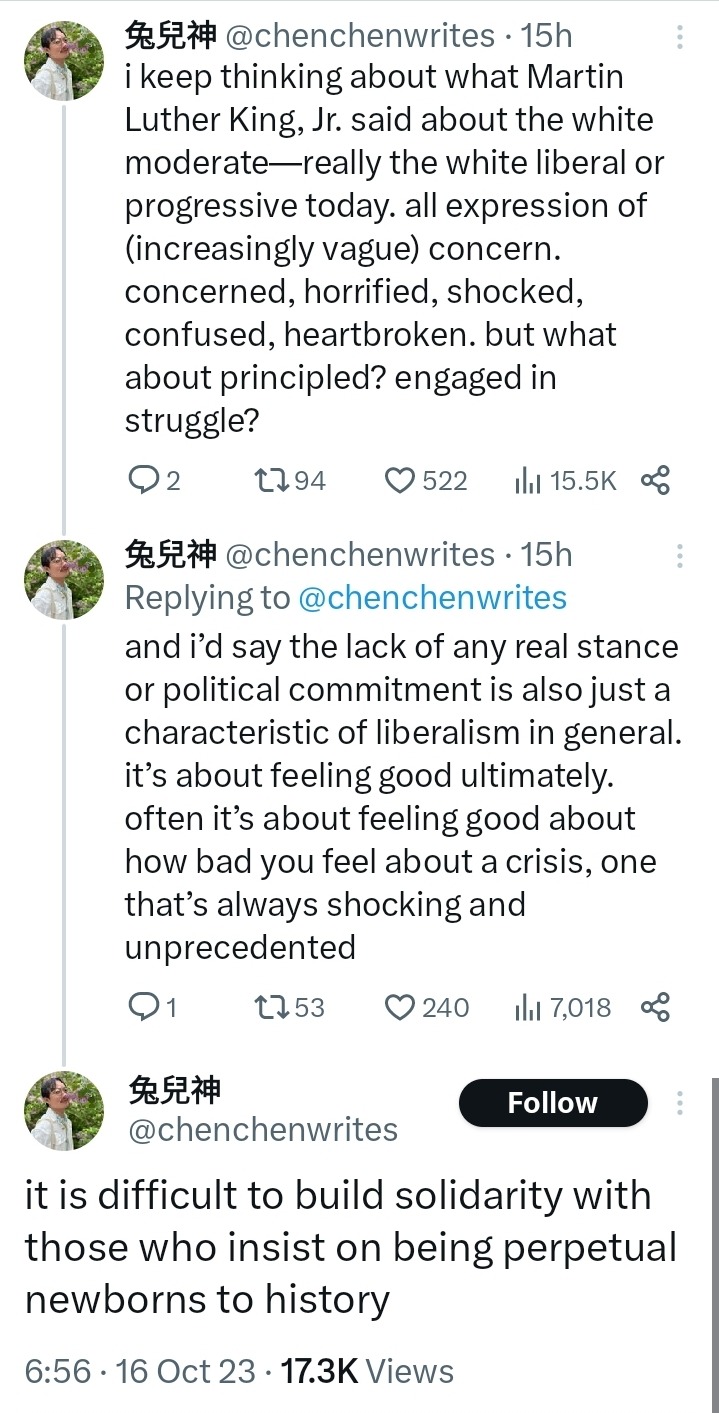
History isn't a disparate collection of stories from long ago. It's the necessary context for the present moment and the forecast for the future. All histories are intertwined, and the narratives of power and privilege, oppression and resistance, adversity and triumph are as constant in their patterns as the laws of physics.
#free palestine#black lives matter#landback#civil rights movement#war on terror#fascism#imperialism#colonization#genocide#colonialism#indigenous sovereignty#climate change#military industrial complex#current events#labour rights#trans genocide#eugenics#this describes literally every political struggle going on right now#and western leftists and liberals are like pikachu face and handwringing every damn time and I AM TIRED#you dont even need to know the entire history of palestine and israel#you just need to understand how colonization and ethnic cleansing and fascism WORKS#you are morally obliged to actively seek education and have a unequivocal stances against violation and annihilation#knee of huss
694 notes
·
View notes
Text

Troops of the British 3rd Infantry Division come ashore on Sword Beach, 0845 hours, 6 June 1944. They are led by the 84th Company of Royal Engineers. In the middle distance, medics tend to wounded men, while at the rear, commandos of the 1st Special Service Brigade disembark from landing craft. Photo credit: Sgt. J. Mapham/Imperial War Museum.
#history#military history#photography#historic photography#D-Day#Operation Overlord#Normandy landings#British Army#World War 2#black and white#b&w#b&w photography#Imperial War Museum
169 notes
·
View notes
Text
In early 2014, Ukraine was a neutral country, with a pro-Russian president, and with 70% of Ukraine's population against NATO membership. Yet Russia bluntly violated Ukraine's neutrality and annexed Crimea, then launched a covert invasion of Ukraine in the east.
Petro Poroshenko won the presidential election later in 2014 having promised a settlement with Russia, keeping a special status of the Russian language in Ukraine. He was initially sceptical regarding NATO accession, underlined Ukraine must rely on its own strength to provide security.
Did Putin meet Poroshenko halfway? Not at all. The regular Russian army entered the Ukrainian territory in mid-2014 to fight the Ukrainian troops, which led to the Minsk-1 agreement signed in September 2014.
Further text - down under the cut, or you can follow the Twitter link to the original post:

Few weeks later, Ukraine's parliament adopted a law that would guarantee the then Russia-controlled part of Donetsk and Luhansk regions additional economic, financial and cultural powers.
How did Putin react? Russia staged sham local elections in the occupied Donbas, and then sent the regular army again to Ukraine in early 2015, which led to the Minsk-2 agreement signed in February 2015.
Zelensky was even more sceptical regarding NATO accession. Asked about NATO, he once famously said he never pays anyone a visit if he has not been invited. He won the presidential election promising to compromise with Russia - to stop shooting, sit down with Putin and talk.
Did Putin meet Zelensky halfway? Not at all. He actually raised the stakes by issuing the Russian passports on the occupied territories of Ukraine even before Zelensky assumed the office, putting him in a difficult political position since the start.
Zelensky was ready to drop Ukraine's NATO bid in an exchange for the Russian troops withdrawing from Ukraine. The talks were held already before 2022. What did Putin do? He launched a full-scale invasion of Ukraine.
In the first weeks of the invasion, Zelensky was yet again ready to drop Ukraine's NATO bid. But he wanted to obtain international security guarantees. What did Putin do? He demanded that Russia must be consulted before any aid would be given to Ukraine in the event of aggression.
To sum up, Ukraine has consistently tried to reach a deal with Russia over the last decade, and was open to giving up on its NATO bid in exchange for the withdrawal of the Russian troops from Ukraine. Russia never reciprocated, never showed a good will, kept raising the stakes.
Both Poroshenko and Zelensky were initially sceptical regarding Ukraine's accession to NATO. Both wanted to get a deal with Putin. And Putin himself pushed both of them to seek NATO membership out of no other viable alternatives.
Up till now, Putin has shown absolutely no willingness to compromise with Ukraine. His war aims remain maximalist - subjugating Ukraine and changing its regime. He seeks Ukraine's partition, and will turn what is left of Ukraine into Russian protectorate.
Russia's imperial self-conception is that of Russian elites at large, and not just Vladimir Putin. The Russian leadership simply cannot reconcile with the existence of a sovereign Ukrainian statehood.
Therefore any sustainable Ukrainian-Russian compromise is currently not possible unless the Russian cost-benefit calculus changes. Only credible risk to the stability of the Russian regime would impact this calculus. The easiest way goes through defeating Russia in Ukraine.
#russia simply wants all of Ukraine#thats it#its a no-brainer#russia considers Ukraine its own colony that needs to be returned under the rule/protectorate of the 'Russian Empire'#same with Georgia Moldova the Baltic States etc#having not achieved military and political victory in Georgia through small wars#russia used its oil money and spy network to install russia-loyal government in Georgia#now that government passes russia-dictated laws#it cant take on the Baltic States (yet)#leaving Ukraine and Moldova#Georgian scenario didnt fly in Ukraine and Moldova so russia went with war#Ukraine is first simply due to the geographical position#Moldova is currently impossible for russia to attack on land and the sea corridor is veeeeerrrrryyyyy narrow and they'd have to go through#Ukrainian and Romania's waters for it#plus Moldova doesn't border Russia#Ukraine borders Moldova#strategically it makes 100% sense to go through Ukraine first#ukraine#russia#russia ukraine war#russian invasion of ukraine#russia is a terrorist state#imperialism#colonialism#genocide#history#war crimes#russian empire#russian culture#україна
144 notes
·
View notes
Text

Imperial Japanese Navy Air Force Kanoya Air Base circa May 1945 in Kanoya, Kagoshima, Japan.
#ww2#pacific war#wwii#wwii era#japan#japanese#japanese empire#world war 2#second world war#world war two#world war ii#Pacific#1940s#kamikaze#air force#air base#imperial japanese navy#ww2 history#ww2 aircraft#military aircraft#tumbler#photography#war history#world war#war#asia#1945#pilots#history#wwii history
77 notes
·
View notes
Text








From The Russian Army 1914-18
Early War Uniforms (1914-1915)
At the outbreak of the war, Russian Imperial Army uniforms were traditional and formal, inspired by 19th-century European military fashion. Key features included:
Infantry: Soldiers wore the gymnastiorka, a pullover-style tunic with a standing collar, often in olive green or khaki to blend with rural landscapes. Rank was indicated by colored collar tabs and shoulder boards.
Headgear: Soldiers wore the M1910 peaked cap, which had a leather visor and badge. Officers and guards regiments wore the iconic shapka, a tall fur hat, especially in colder climates.
Footwear: Soldiers wore sapogi (knee-high leather boots), which were sturdy but hard to maintain on the battlefield.
Cavalry and Specialized Units: The cavalry wore the traditional long blue or dark green overcoat with distinct colored cuffs and collar insignia. Cossack and other specialized units had specific, unique uniforms, often featuring traditional garments like the cherkesska (a type of coat) and decorative braid.
Mid-War Changes (1915-1916)
As the war progressed, Russia’s economy and industry struggled to keep up with demand, leading to simplifications in uniforms:
Tunic: The gymnastiorka became simpler, often without the colored collar tabs or decorative elements. Khaki shades became standard as brighter colors were deemed impractical.
Greatcoat: The heavy wool shinel (overcoat) remained a staple, especially during harsh winters, but there was a shortage of quality fabric, and lower-quality cloth began to appear.
Headgear: Caps were simplified, with many soldiers receiving the budenovka (a soft, pointed wool cap) by 1917. This cap became especially popular in winter regions but had limited protection.
Late-War Uniforms (1917-1918)
The Russian military was increasingly influenced by revolutionary sentiments, and practical, minimal designs became the norm:
Tunic and Coats: Uniforms were pared down further, with basic olive-drab tunics and greatcoats. Rank insignia were minimal and often overlooked as soldiers became more focused on function than formality.
Insignia: Some units began to remove the imperial insignia altogether due to the influence of the Bolsheviks. Instead, red armbands or patches occasionally appeared.
Boots: Soldiers frequently substituted traditional boots with puttees (long cloth wraps) due to the shortage of leather, a trend seen across European forces during this period
#military art#history#cavalry#soldier#military#historical fashion#the great war#world war 1#russian history#russian empire#tsar Nicholas ii#imperial Russian history
34 notes
·
View notes
Text


Olga and Tatiana, c. 1911.
#romanovs#history#romanov#romanov family#historical photos#imperial russia#russian royalty#russian imperial family#olga nikolaevna#tatiana nikolaevna#romanov sisters#the big pair#military regiment#military uniform#1910s#1911#c. 1911#historical photo#romanov informals
25 notes
·
View notes
Text
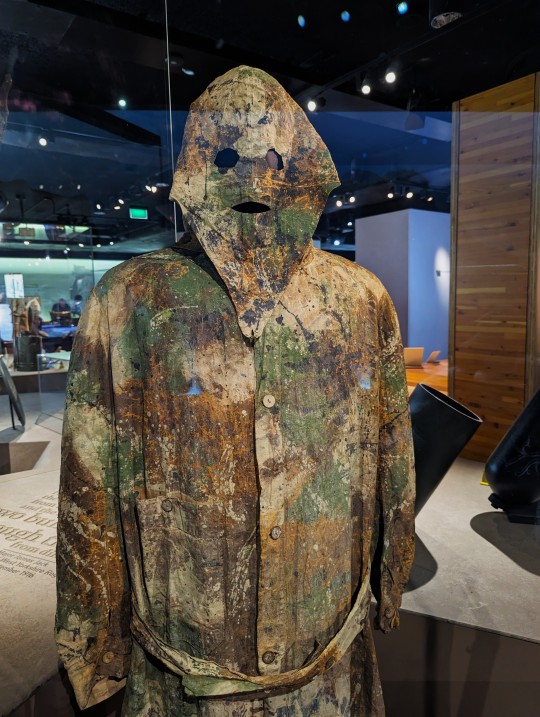
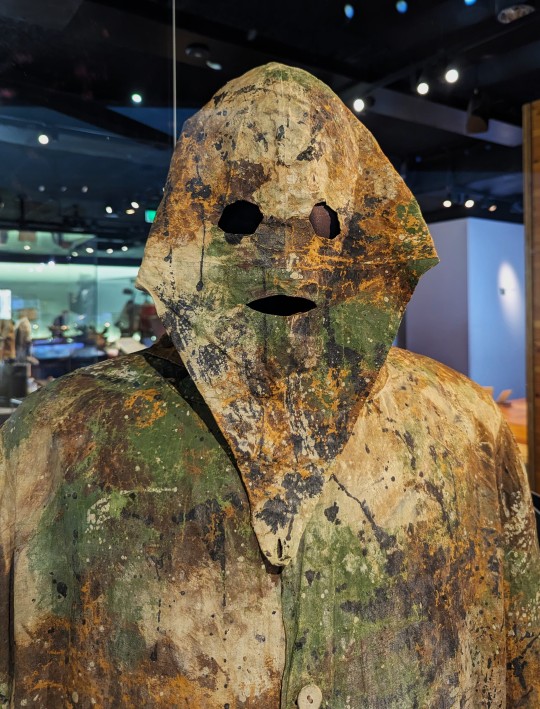
Sniper Robe from the British Empire dated to around 1916 on display at the Imperial War Museum in London, England
Many British Army snipers were trained by former Highland gamekeepers and deer stalkers of the Lovat Scouts, who gave extensive guidance on sniper's field service attire based on their extensive professional skills in improvising personal camouflage and their practical experience of effective concealment. As a result a wide variety of camouflage clothing schemes were adopted on the Western Front, either improvised or officially produced; these included mittens, gaiters and robes.
Photographs taken by myself 2023
#uniform#fashion#20th century#military history#british empire#first world war#imperial war museum#london#barbucomedie
121 notes
·
View notes
Text

• Satoru Anabuki (Japanese IJAAF Ace)
Lieutenant Colonel Satoru Anabuki 穴吹 智, Anabuki Satoru, was depending on the source, the second or third highest-scoring flying ace of the Imperial Japanese Army Air Force in World War II, with 39 victories (51 claimed).
Born into a farming family in the Kagawa Prefecture, he graduated high school to take the entrance examination for the Juvenile Flying Soldier School and entered the Tokyo Army Aviation School in April 1938, In Oct 1940, he was enrolled in Tachi'arai flight school in Fukuoka Prefecture graduating in March 1941 in the 6th Juvenile Soldier Course and receiving a promotion to corporal in October. He was assigned to the 3rd Company of the 50th Air Squadron, stationed on Formosa in 1941. With the outbreak of the Pacific War, he fought in the conquest of the Philippines, where he claimed his first victory, a Curtiss P-40, on December 22nd, 1941 flying a Ki-27 aircraft. On February 9th, 1942, he shot down two more.
He returned to Japan with his squadron in Apr 1942, where the squadron was re-equipped with Ki-43 Hayabusa aircraft; Anabuki named his new fighter "Fubuki", partially based on his own surname. In Jun 1942, his squadron was transferred to Burma, where he would see combat over Burma, India, and southwestern China. He was promoted to the rank of sergeant in Dec 1942. On December 20th, 1942, he shot down a Blenheim bomber over Magwe, Burma, the first of many bomber victories. On December 24th, he shot down three British Hurricane fighters in combat over Magwe, Burma. In May 1943, he received a new Ki-43 fighter; he named this new aircraft "Kimikaze" after his wife Kimiko. He was seriously wounded in combat while flying "Kimikaze" over Rangoon, Burma on October 8th, 1943; after initial recuperation, he was transferred to the Akeno Army Flying School in Ibaraki Prefecture, Japan in Feb 1944.
In late 1944, after being cleared to fly once again, he shot down four US F6F Hellcat fighters over Takao, Taiwan and the Philippine Islands while ferrying Ki-84 Hayate fighters from Japan southwards. In December 1944, he was promoted to the rank of sergeant major. In the final months of the war, he was an instructor at Akeno with frequent combat assignments; in this role, he scored his 39th and final confirmed victory (53rd claimed victory), a B-29 bomber, over Japan while flying a Ki-100 fighter. After the war, he joined the Police Reserve in 1950, eventually reaching the rank of captain. Later, he joined the Japan Ground Self-Defense Force, becoming a helicopter pilot stationed in northeastern Japan; he retired from his military career in 1971 at the rank of lieutenant colonel. He worked for Japan Airlines before retiring in 1984. Many of Anabuki's victory claims during the Burma Campaign have been contested by comparing them to Allied records of lost aircraft on particular occasions. In several cases, there were no records of Allied planes even operating in the area where the claims were made. Anabuki passed away on an unknown date in June of 2005 at the age of 83 years old.
#second world war#world war 2#world war ii#wwii#military history#aviation#aviation history#ww2 aces#japanese history#imperial japan#airforce history
29 notes
·
View notes
Text
Vladimir Paley at the Corps des Pages - Part 1

But Volodia's childhood was soon to be over. The grand duke wanted his younger son to follow the dynastic tradition of an army career, and in that same year, 1908, the little Count von Hohenfelsen became a student at the Corps-des-Pages, the Saint Petersburg military school for aristocratic youngsters. Half-ignored by his imperial relatives, he lived in the house of his tutor Colonel Alexander Nikolaiveich Fenu. Both Colonel Fenu and his wife Alya Vladimirovna were very kind to the boy. For Vladimir, suddenly deprived of the loving atmosphere of his family, and forced to face an unknown world, his first days in the Corps-des-Pages were dreadful. He had no military vocation, spoke poor Russian and felt completely out of place in the often rude environment of the school. In his letters to his family, he complained bitterly about his life in the barracks, remembered his Parisian days with nostalgia and dreamed to get out of the school to visit exotic and legendary places. He longed for Easter, summer and Christmas vacations when he was allowed to spend with the family in France or traveling to varied places in Western Europe.
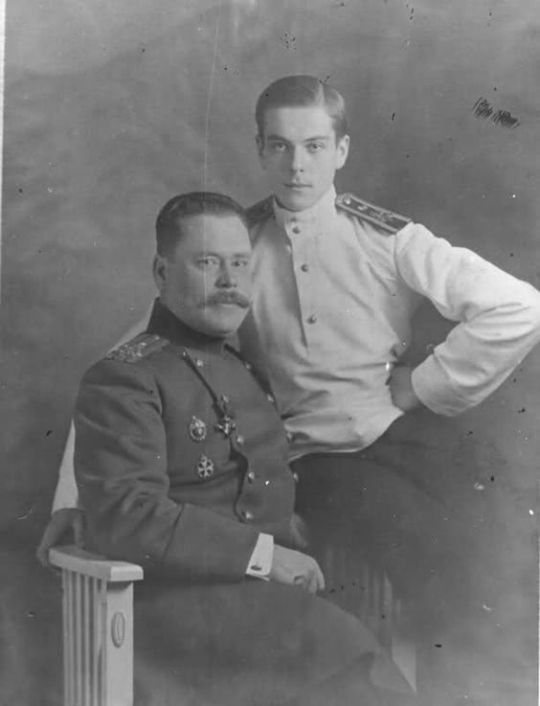
Throughout his stay in the Corps-des-Pages, Volodia continued privately to school himself in painting and music. And it was around 1910 during his first years in the dreaded school, when the young Count von Hohenfelsen started to write poetry, a vocation that never would abandon him. His mother wrote: "Ever since the age of thirteen Vladimir had been writing delightful verses… Each time he returned home his poetic talent displayed itself more decidedly… He availed himself of every free moment to devote his mind to his cherished poetry. By temperament a dreamer, he observed everything and nothing escaped his subtle, watchful attention… He loved nature ardently. He went into ecstasy over everything God had created. A moonbeam inspired him, the scent of a flower gave him an idea for a poem. He had a prodigious memory. What he knew, what he had time to read in his short life, was truly marvelous. Vladimir wrote his first verses in French, the language most familiar to him at that time. The few ones published by Jacques Ferrand in his biography of Grand Duke Paul (Agonie, Les miettes, Indifference, Chanson de Therese, Le Chemineau, Vieillesse), written in 1913, show an already remarkable talent for images and versification, as well as deep feeling. Until this day, however, most of his French poetry remains unpublished in his relatives' archives in France or the archives of the Russian Federation, along with some poetry he wrote in English.

Gradually, the young count got used to the life in the Corps- des-Pages and even started to enjoy it, a situation that probably was encouraged by his progress in Russian, a language he eventually learned with perfection. His letters home became much more joyful. He also found good friends among his classmates who called him Goghen, a russified abbreviation for Hohenfelsen.31 Some of them would perish during the first World War and be remembered by Vladimir in sad verses.
"A Poet Aming the Romanovs" - Jorge F. Sáenz
#romanov#vladimir paley#corps des pages#military academy#grand duke paul#poets#royalty#russian history#russian imperial army#imperial family#olga paley#grand duke#paul alexandrovich
20 notes
·
View notes
Text
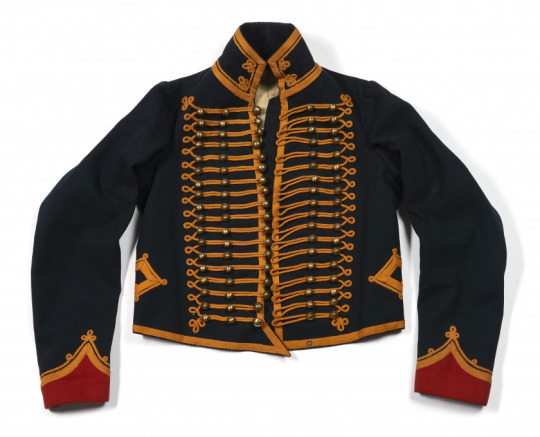

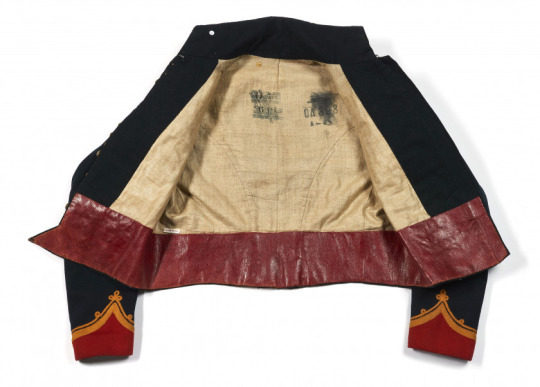
Dolman de chasseur a cheval de la garde imperiale
First French Empire Style, Napoleonic era
(Artcurial — Sale Verly Family Collection - 18 december 2020)
#dolman#jacket#imperial guard#napoleonic era#napoleonic#fashion#fashion history#military uniforms#military#first french empire#french empire#19th century#france#history#Artcurial#auction#Sale Verly Family Collection#soldier#Military fashion#napoleonic wars#French#french history#Chasseurs#la garde imperiale#garde imperiale
124 notes
·
View notes
Note
Hi, I want to ask if you have any topics about the Philippine-American War? I have gotten myself in Philippine History and I want to know deeper. Thanks:)
I was thinking of many ways on how to answer this because this is such a large and complicated topic but I could just try to summarize some stuff here and tell you what I know and what I could find.
The Filipino-American war mainly started as Filipinos felt betrayed by their former American allies after the country was sold to them by Spain after the Spanish-American war during the Treaty of Paris of 1898 for $20 million alongside other Spanish colonies like Puerto Rico, Guam, and Cuba (American Historical Association, n.d.). This feeling of betrayal had come from the fact that the leader and dictator president of the Filipino revolutionaries, Emilio Aguinaldo of the Kataastaasang Kagalang-galang Katipunan ng mga Anak ng Bayan (en. The Supreme and Honorable Association of the Children of the Nation) or the Katipunan for short, actually sought assistance from the Americans in Hong Kong during the Filipino Revolutionary War against Spain which was happening at the same time (Kedmey, 2013). This is why tensions were so high with the Americans when they first formally colonized the Philippines.
Interestingly, the purchase also included some territories that weren't actually part of Spanish rule such as the Sultanate of Sulu as well as some indigenous territories which led to a strained relationship with the Americans moving forward such as the independent Moros of Muslim Mindanao later being forced to assimilate to the rest of the colony of the Philippines despite previous agreements that state that they will leave them alone, mirroring the way the United States government treated Native Americans (Gowing, 1968).
Fighting between the American army and the Filipino army first broke out when on February 4, 1899 after Private William W. Grayson fired at 4 Filipino soldiers who cocked their rifles in response to them ordering the men to halt which later broke out into the Battle of Manile of 1899 (Chaput, 2012). As the Filipinos and Americans declared war on each other, the Katipuneros resorted to the mountains to start guerilla warfare against the American army (Philippine-American War, n.d.) which then lasted until 1901 when Aguinaldo was captured on March 23, 1901, just a day after Aguinaldo's birthday actually with the capture being attributed to two of his men, Lazaro Segovia and Hilario Tal Placido who betrayed him to the Americans with his other men still being too relaxed from the festivities the day before (Ocampo, 2010).
The fighting continued despite his capture and surrender until the last of the generals, General Macario Sakay, surrendered in July 14, 1906 who was then later executed along side his men on September 13, 1907 despite the initial promise of amnesty by the American government (Pangilinan & Pimintel, 2008).
The war ended the lives of 4,300 American soldiers with only 1,500 having been killed in action with the rest succumbing to diseases, while Filipino forces suffered 20,000 casualties alongside the death of 200,000 Filipino civilians due to hunger, disease, and combat (Philippine-American War, n.d.).
The violence of the situation and especially committed by the American soldiers prompted a lot of protests in the United States to stop the war immediately, as letters of the situation had been sent back to their homes which describes in excruciating detail the war crimes that these soldiers were ordered to commit such as blockading and burning down villages, extreme torture of captured and suspected enemies, and much more. The most well-known of these torture methods that I remember being taught to us in history classes as early as 4th grade was the "Water Cure" where American soldiers would force water down the victim's throat in and force them to vomit it back out. This article has a detailed account of the exact nature of this torture method as it discusses the torture of Mayor Joveniano Ealdama of Igbaras, who, although no American troop was actually hurt in his town, was tortured with his town being burnt down by the Americans the very next day (Vestal, 2017).
I do have to be honest, I was utterly shocked at how little Americans really knew about the Philippine American colonial era and by extension the Philippine-American war especially with the sheer amount of brutality the Americans had done to Filipino locals as well as the large impact the American government and American culture has had in my country and I am glad that more and more people are starting to learn more about this but it's still rather disappointing.
Videos on the Philippine-American War
If you want to learn more about the Philippine-American War, I have a couple of recommendations for videos that you can watch.
This video by Crash Course explains the origins of American Imperial idealization as well as the wars that led up to the colonization of the many territories that America acquired during this time era:
youtube
Here's a good summary by history teacher Mr. Beat of the major aspects of the war as well as the American public's perception of it that you can watch:
youtube
Here's a video made with a Filipino-perspective by Jonas Tayaban on the topic:
youtube
Here's a summary in Tagalog. It doesn't have English subtitles though but it does detail more things about the build-up and the subsequent wars between Spain and America and later the Philippines and Spain and then America too:
youtube
Movies about the Philippine-American War
I would also be remiss to not suggest some historical movies that tackle the events of this time period and especially TBA Studios' Artikulo Uno films Heneral Luna (2015) which focuses on the most popular and effective general of the revolution Gen. Antonio Luna, and Goyo: Ang Batang Heneral (2018) which focuses on Gregorio "Goyo" del Pilar, one the youngest generals of Filipino history who died a very tragic death at a young age:
youtube
You can watch the full movie here complete with English Subtitles
youtube
Another well-known movie about this time period is Viva Films' El Presidente (2012), although I had heard people say it's very much biased to the controversial dictator president Aguinaldo's side with many people citing that as the reason why they don't like the film.
youtube
Here's a reupload of the full-movie. It doesn't have subtitles though.
I don't know of any American-made movies that focuses on this topic and I know there's several other films that focus more on the politics of the Katipunan and the Filipino Revolutionary War against Spain, but not necessarily the Philippine-American War so if anyone has other suggestions, please let me know.
I would also like to suggest documentaries but most of the ones I've seen are on World War II and the others are other YouTube videos by history channels that I'm not too familiar with made by mostly white American YouTubers. Not that that would disqualify their videos (I did reference both John Green and Mr. Beat here) but I don't know these history channels and their hosts enough to recommend them in good faith as of right now.
Books and Further Reading on the Philippine-American War
For books on the subject, I often reference the many writings of Ambeth Ocampo such as his Looking Back series, specifically:
Looking Back 2: Dirty Dancing (Shopee, Lazada, Amazon)
Looking Back 11: Independence x6 (Shopee, Lazada)
Looking Back 13: Guns of the Katipunan (Shopee, Lazada)
I'm also currently interested in buying some other books about the topic like The Hills of Sampaloc: The Opening Actions of the Philippine-American War, February 4-5, 1899 (Shopee, Amazon) but I don't really have any extra money to spare for it right now.
I remember that my father had some other books about this too but the names had escaped me and it's far too much work to try to sort out through his entire book pile in our house.
I hope this answer's comprehensive enough since the subject is, as I said before, quite complex and rather large so I can't really get into all the specifics right now.
References:
American Historical Association. (n.d.). How Did America Enter the Picture?. Retrieved on 3 February 2024, from https://www.historians.org/about-aha-and-membership/aha-history-and-archives/gi-roundtable-series/pamphlets/em-24-what-lies-ahead-for-the-philippines-(1945)/how-did-america-enter-the-picture
Chaput, D. (2012). Private William W Grayson's War in the Philippines, 1899. Retrieved on 3 February 2024, from https://ne-test-site8.cdc.nicusa.com/sites/ne-test-site8.cdc.nicusa.com/files/doc/publications/NH1980GraysonWar1899.pdf
Gowing, P. (1968). Muslim-American Relations in the Philippines, 1899-1929. Retrieved on 3 February 2024, from https://asj.upd.edu.ph/mediabox/archive/ASJ-06-03-1968/gowing-muslim-american%20relations%20in%20the%20philippines%201899-1920.pdf
Kedmey, D. (2013, June 13). Exiled in Hong Kong: Famous Company for Edward Snowden.Time. Retrieved on 3 February 2024, from https://world.time.com/2013/06/15/exiled-in-hong-kong-famous-company-for-edward-snowden/slide/general-emilio-aguinaldo/
Ocampo, A. (2010). Looking Back 2: Dirty Dancing. Anvil Publishing
Pangilinan, F., & Pimintel, A. (2008, September 9). A Resolution Expressing the Sense of the Senate Honoring the Sacrifice of Macario Sakay and all other Filipinos who Gave Up their Lives in the Philippine-American War for our Freedom, Senate Resolution No. 623, 14th Congress of the Republic of the Philippines. Retrieved on 3 February 2024, from http://legacy.senate.gov.ph/lisdata/83927584!.pdf
Philippine-American War. In Britannica. Retrieved on 3 February 2024, from https://www.britannica.com/event/Philippine-American-War
Vestal, A. (2017). The First Wartime Water Torture by Americans. Retrieved on 3 February 2024, from https://digitalcommons.mainelaw.maine.edu/mlr/vol69/iss1/2/
#filipinfodump#filipino history#american history#history#filipino-american history#philippine-american war#military history#colonial history#imperialism#american imperialism#american colonization#american colonial era#philippines#america#filipino#katipunan#us military#president emilio aguinaldo#general antonio luna#general gregorio del pilar#filipino heroes#filipino presidents#john green#crash course history#crash course american history#mr. beat#jonas tayaban#moobly tv#filipino movies#heneral luna (2015)
95 notes
·
View notes
Text

A First World War propaganda piece by Harry Payne, showing a ghostly array of soldiers surrounding a sleeping man with the caption, "WHAT ARE YOU DOING TO GUARD THE HOMES OF ENGLAND?"
It's not unusual to see war propaganda drawing on the military glory of past generations. What makes this weird is that the artist was well-known for illustrating historical military scenes, and yet he chose to depict so many Victorian era British soldiers from after the Napoleonic Wars.
Buddy, I don't think the guy from the Anglo-Afghan War is guarding the homes of England, or the guy who put down the Indian Rebellion in 1857. The Crimean War guy is not guarding anyone's home, the guy from the Third Anglo-Burmese War is not helping you etc etc.
#harry payne#great war#military history#imperialism#local soldier too busy invading distant foreign land
24 notes
·
View notes
Text
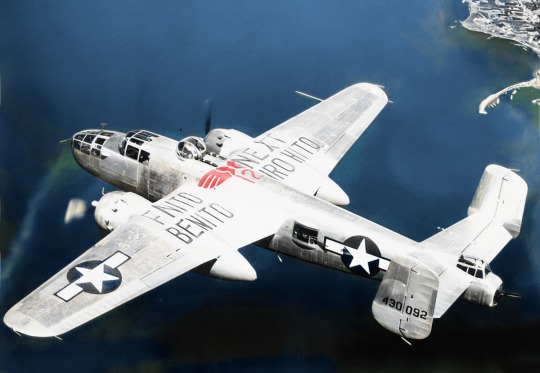
"Finito Benito, Next Hirohito" B-25J 12th Bomb Group. Italy, 1944.
A clear message. Priceless!
#youtube#aircraft#airplane#ww2#aviation#wwii#dronescapes#military#documentary#bomber#fascisim#imperialism#hirohito#mussolini#benito#usa#aviation lovers#aviation photography#aviation history#colorized#italy#mediterranean#catch phrase#war in color#wwii airplane#wwii era#wwii history#world war two#ww2 bomber#ww2 aircraft
87 notes
·
View notes
Text
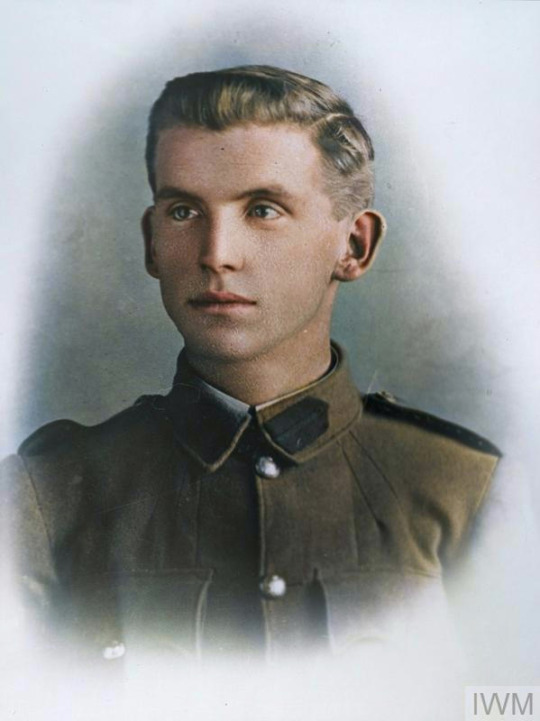
Sergeant Leslie Collins, Australian Imperial Force Killed in action at Lone Pine Gallipoli on 07/12 August 1915, aged 21. Son of Daniel and Esther Collins, New South Wales.
#Australian Imperial Force#ANZAC#World War One#The Great War#1918#1917#1916#1914#first world war#history#historical#historical photos#world history#canadian history#military history#british army#Indian History#war#military#somme#Battle of the Somme#france#belgium#the western front#vimy ridge#Battle of Vimy Ridge
24 notes
·
View notes
Text
Field guns for the Guard. Printed the gun and the gunners. Based with coffee stir sticks and vallejo European Mud. Sandbags are painted green stuff. A lot of time into a unit that isn't very good right now.
STL is The Makers Cult Valor Korps Support Guns.
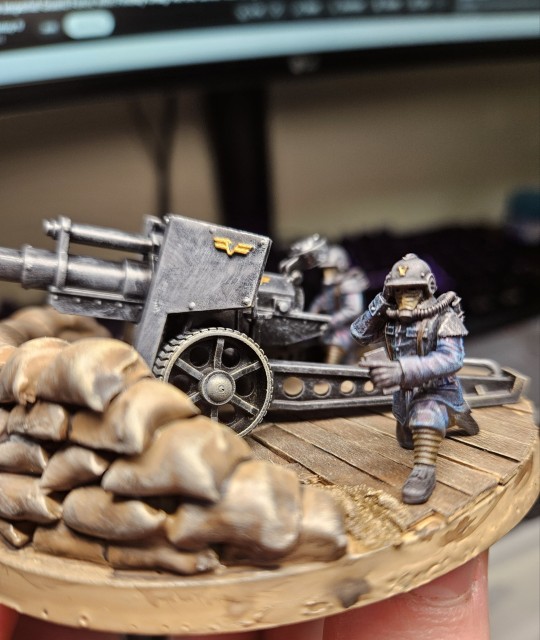
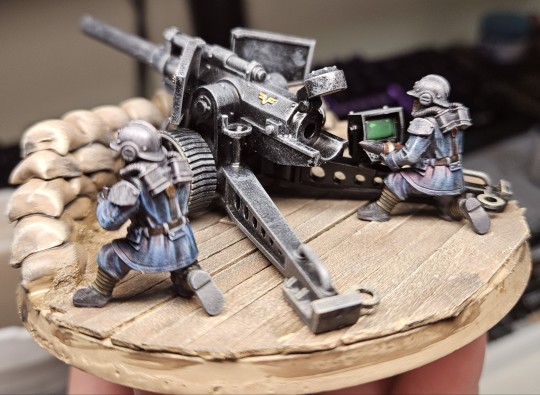

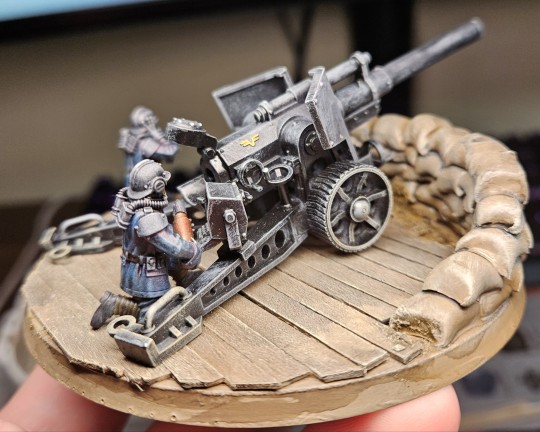
#warhammer 40k#warhammer#40k#death korps of krieg#miniature painting#astra militarum#imperial guard#hobby#military history#military
41 notes
·
View notes